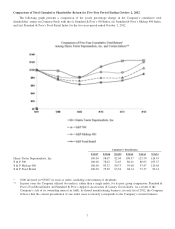Harris Teeter 2012 Annual Report Download - page 21
Download and view the complete annual report
Please find page 21 of the 2012 Harris Teeter annual report below. You can navigate through the pages in the report by either clicking on the pages listed below, or by using the keyword search tool below to find specific information within the annual report.where the facts and circumstances dictate. Historically, the Company’s assumptions and judgments regarding vendor rebates,
credits and promotional allowances have been reasonably accurate. Management believes that future changes in these
assumptions and judgments are not reasonably likely to have a material effect on the Company’s financial condition and results
of operation.
Inventory Valuation
Merchandise inventory is valued at the lower of cost or market with the cost of a substantial portion of inventories being
determined using the last-in, first-out (LIFO) method. Limited categories of inventories are valued on the first-in, first-out (FIFO)
cost methods. In total, approximately 84% of inventories were valued using the LIFO method in both fiscal 2012 and fiscal
2011. Cost for the balance of the inventories was determined using the FIFO method. The excess of estimated current costs
over the LIFO carrying value, or LIFO reserve, was approximately $42.4 million and $39.4 million as of October 2, 2012 and
October 2, 2011, respectively. LIFO assumes that the last costs in are the ones that should be used to measure the cost of goods
sold, leaving the earlier costs residing in the ending inventory valuation. The Company uses the “link chain” method of
computing dollar value LIFO whereby the base year values of beginning and ending inventories are determined using a
cumulative price index. The Company generates an estimated internal index to “link” current costs to the original costs of the
base years in which the Company adopted LIFO. The Company’s determination of the LIFO index is driven by the change in
current year costs, as well as the change in inventory quantities on hand. Under the LIFO valuation method, all retail store
inventories are initially stated at estimated cost as calculated by the Retail Inventory Method (RIM). Under RIM, the valuation
of inventories at cost and the resulting gross margins are calculated by applying a calculated cost-to-retail ratio to the retail value
of inventories. RIM is an averaging method that has been widely used in the retail industry due to its practicality. Inherent in
the RIM calculation are certain significant management judgments and estimates, including markups, markdowns, lost inventory
(shrinkage) percentages and the purity and similarity of inventory sub-categories as to their relative inventory turns, gross
margins and on hand quantities. These judgments and estimates can significantly impact the ending inventory valuation at cost,
as well as gross margin. Management believes that the Company’s RIM provides an inventory valuation which reasonably
approximates cost and results in carrying the inventory at the lower of cost or market. Historically, the Company’s assumptions
and judgments regarding the Company’s RIM have been reasonably accurate. Management does not believe that the likelihood
is significant that materially higher LIFO reserves are required given its current expectations of on-hand inventory quantities
and costs.
The proper valuation of inventory also requires management to estimate the net realizable value of the Company’s obsolete
and slow-moving inventory at the end of each period. Management bases its net realizable values upon many factors including
historical recovery rates, the aging of inventories on hand, the inventory movement of specific products and the current economic
conditions. When management has determined inventory to be obsolete or slow moving, the inventory is reduced to its net
realizable value by recording an obsolescence reserve. Given the Company’s experiences in selling obsolete and slow-moving
inventory, management believes that the historical estimates used to value obsolete and slow-moving inventory have been
reasonably accurate.
With regard to the proper valuations of inventories, management reviews its judgments, assumptions and other relevant,
significant factors on a routine basis and makes adjustments where the facts and circumstances dictate.
Self-insurance Accruals for Workers’ Compensation, Healthcare and General Liability
The Company is primarily self-insured for workers’ compensation claims, healthcare claims and general liability and
automotive liability losses. The Company has purchased insurance coverage in order to establish certain limits to its exposure
on a per claim basis. The Company’s self-insurance accruals for workers’compensation insurance and general liability insurance
totaled $32.6 million and $31.3 million as of October 2, 2012 and October 2, 2011, respectively.
Actual workers’ compensation claims, and general liability and automotive liability losses, are reported to the Company
by third party administrators. The third party administrators also report initial estimates of related loss. The open claims and
initial loss estimates are subjected to examination by the Company’s risk management and accounting management utilizing
a consistent methodology which involves various assumptions, judgment and other factors. Such factors include but are not
limited to the probability of settlement, the amount at which settlement can be achieved, the probable duration of the claim,
the cost development pattern of the claim and the applicable cost development factor. The Company determines the estimated
accruals required for worker compensation claims in each accounting period. This requires that management determine estimates
of the costs of claims incurred and accrue for such expenses in the period in which the claims are incurred. The Company
measures the liabilities associated with claims for workers’ compensation, general liability and automotive liability through the
use of actuarial methods to project an estimate of ultimate cost for claims incurred. The estimated cost for claims incurred are
discounted to present values using a discount rate representing a return on high-quality fixed income securities with an average
17
























